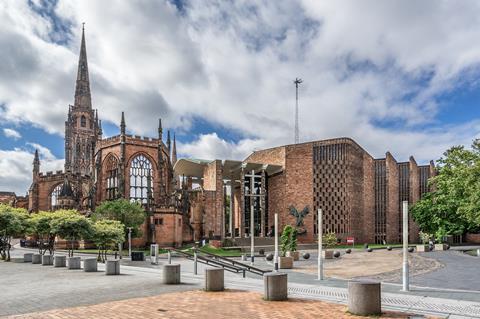From the prioritisation of cars to residential zoning and a disinclination to rebuilding lost buildings, no British city tells the story of post-war planning better than Coventry, writes Nicholas Boys Smith

In the 1920s, the Swiss architect, Le Corbusier, funded by a car producer, dreamed of sweeping away the boulevards of Paris and replacing them with sixty storey concrete towers, zoned by class and linked by fast roads in open parkland. It never happened.
In 1944 Patrick Abercrombie’s Greater London Plan proposed five ring roads for London (including the inner ‘Motorway Box’) and the resettlement of half a million people, including 40 per cent of the East End, to new ‘satellite towns.’ It never happened.
Coventry’s brush with mid-twentieth century urban design was more profound. No British city tells the story of post-war planning better than Coventry, which in the 1930s was the innovative Silicon Valley of the early British motor industry besides a medieval cloth town. When J. B. Priestly, visited in 1934 he found it so attractive that, he wrote, ‘it might have been transported to Italy.’
Unfortunately, the concentration of Coventry’s factories made the city a tempting target in the blitz which damaged two thirds of the city’s buildings and destroyed 4,300 homes. Many historic buildings survived, however. In 1945 the city still had over 120 medieval timber houses. What to do?
Coventry’s first city architect, Donald Gibson, was certain. He wrote that the bombs were “a blessing in disguise. The jerries cleared out the core of the city, a chaotic mess, and now we can start anew…. We used to watch from the roof to see which buildings were blazing and then dash downstairs to check how much easier it would be to put our plans into action.”

Unsurprisingly, for the city that made cars, the vision was for a future Coventry for cars. Gibson was clear that “it would be fitting for the centre of the motor car industry to give a lead.” His initial plans, as shown in a 1945 scale model, were to demolish almost all of the city centre, including the bombed cathedral’s ruins. He was obliged to temper this but many of the surviving historic buildings were demolished, a new ring road built and the quilt of medieval streets largely cut away. Some residents were delighted. However, 1945 local newspaper reports suggest that many more agreed with the plea of one newspaper correspondent: “give us back Coventry as we knew it.”
Modern Coventry has real merits. Most admire Basil Spence’s new cathedral (“surely the last modern building that the general public queued to see” wrote one historian). However, as the journalist, Daniel Knowles, observed, “nobody would compare visiting Coventry to being transported to Italy now.”
Modern Coventry’s vision has turned full circle. Instead of a city to drive round, the city council is now committed to a city with more walking and cycling, with three major new cycle routes. The town centre is being regenerated and post-war buildings being replaced or improved. The plans bring people back into the city’s heart with 1,500 new homes. This reverses the city’s post war zoning which largely banished homes to beyond the central ring road. However, unlike its twin Dresden or similarly destroyed cities such as Warsaw or Berlin, there are no plans to recreate lost streets or buildings.
Twentieth century Coventry was a city for cars and, sadly, ultimately declining prosperity. Will twenty-first century Coventry be a city for more people and increased prosperity?
>> Also read: How the people of Dresden campaigned to rebuild the lost heart of their city
Postscript
This article was originally published to accompany Create Streets’s Restitch social fabric summit, held in Coventry, 7-8 March 2024.
Nicholas Boys Smith is the founding director of Create Streets.
















1 Readers' comment